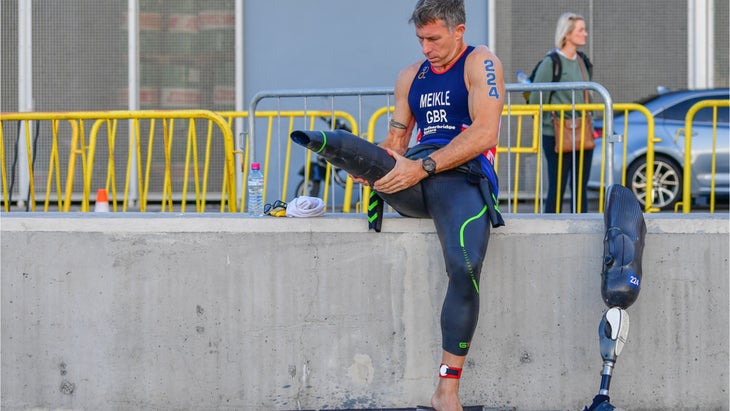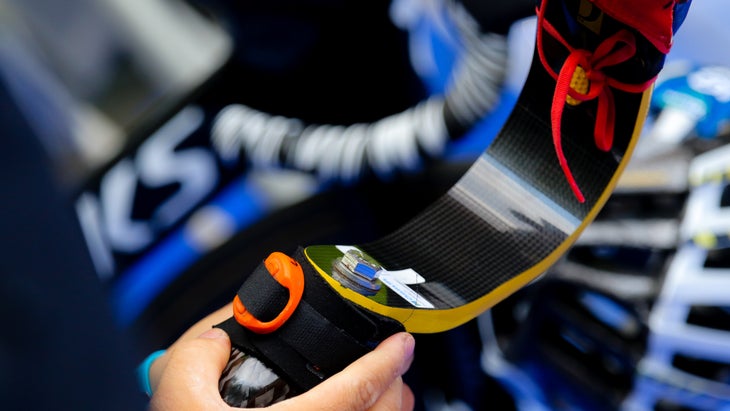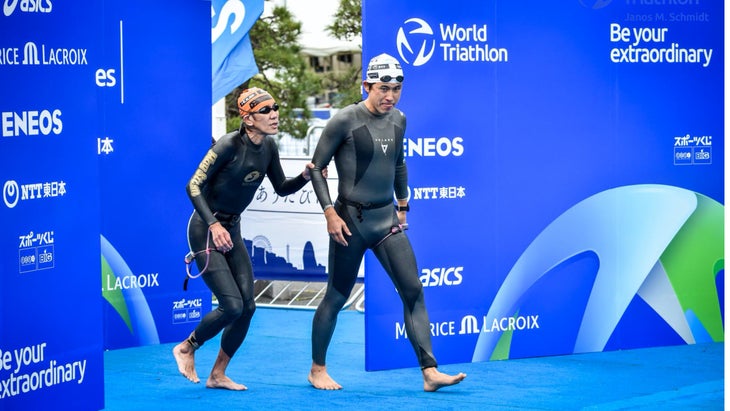New perk! Get after it with local recommendations just for you. Discover nearby events, routes out your door, and hidden gems when you sign up for the Local Running Drop.
In a triathlon, every second counts, including the seconds spent in the transition from swim-to-bike (T1) and bike-to-run (T2). While a speedy transition is unlikely to be the sole reason one wins a race, it can definitely be the reason an athlete loses precious seconds if they fumble with a helmet or trip over their own feet. Now, imagine the pressure of a triathlon transition, but add in a prosthetic leg. Or a vision impairment. Or having limited use of a limb.
For Paralympic triathletes, transitions are often described as the trickiest part of their race, due to the complexities disabilities can add to T1 and T2, which can increase the time spent going from swim to bike or bike to run. But just like all triathletes, these Paralympians have faced their challenges head on to become aces at nailing this aspect of their sport.
Read on for three perspectives on how triathletes at the Paralympic Games navigate their unique transition area:
Allysa Seely
Two-time Paralympian, 2016 Paralympic Gold Medalist
PTS2 Classification
In the Paralympics, athletes compete in classifications that groups them with other athletes who have a similar disability. Two-time Paralympic and 2016 Paralympic gold medalist triathlete Allysa Seely competes in the PTS2 classification, which is defined by World Triathlon as: “Severe impairments. In both bike and run segments, amputee athletes may use approved prosthesis or other supportive devices. Includes athletes with comparable activity limitation and an impairment of, but not limited to, limb deficiency, hypertonia, ataxia and or athetosis, impaired muscle power or range of movement.”
RELATED: What is Paratriathlon? Understanding Triathlon in the Paralympics
Seely uses a full-length leg prosthetic, which she does not wear in the swim. Because she will need her leg prosthetic at the swim exit, her preparation for transition starts even before the gun goes off.
“In paratriathlon, we have what’s called pre-transition,” Seely said. “Pre-transition is generally right at the water’s edge and is where we are allowed to put any gear—such as a prosthetic—that will help us get from the water into T1.” Before the race, Seely places her run-specific prosthesis in pre-transition. After she is assisted out of the water by volunteers, she throws on her run leg in a matter of seconds and heads toward her bike.

It’s also important to note that pre-transition counts toward a paratriathlete’s total race time, so just like with any other part of a triathlon, each second counts. If triathlon has T1 and T2, it may help to think of pre-transition as T.5.
Once Seely arrives at her bike, she puts on a different prosthesis. “I swap out my run leg for my bike leg once I’ve arrived in T1. It’s a really simple process: there is a black sleeve that you’ll see around my leg in the bike and run. This black sleeve works with the prosthetic by holding it in place via positive pressure. I just throw on the sleeve over my new prosthetic and am ready to go.”
As Seely rolls into T2 after completing the bike course, she completes a flying dismount at the transition line. “You can imagine that completing a flying dismount with a prosthetic is a bit jarring,” Seely joked. “But I’ll execute one and then head toward my transition area to swap out my bike leg for my running leg.”
Unlike bike prostheses, which have a more traditional “calf and foot” look, running legs are the J-shaped “blades” many of us are used to seeing at the Paralympics. The J-shaped look of the prosthetic allows athletes to better absorb the approximately 800 pounds of force we all transfer through our feet when we run.
RELATED: The Science and Controversy of Running Blade Prosthetics
RELATED: Carbon Legs, Aerodynamic Speed Machines, and…Shoelaces?
Seely’s advice for those getting into the sport who may also use a prosthetic is to “practice, practice, practice.”
“Everyone has a different process that works for them and their prosthetic,” Seely added. “So find what works for you and don’t be afraid to think outside the box in terms of what will efficiently and smoothly move you through pretransition, T1, and T2.”
Grace Norman
2x Paralympian, 2016 Gold Medalist
PTS5 Classification
Grace Norman also competes with a prosthetic. Norman’s prosthesis attaches at her knee. She races in the PTS5 division, which is defined as: “Mild impairments. In both bike and run segments, amputee athletes may use approved prosthesis or other supportive devices. Includes athletes with comparable activity limitation and an impairment of, but not limited to, limb deficiency, hypertonia, ataxia and or athetosis, impaired muscle power or range of movement.” Transitions have been a key focus of her preparation for the Games with coach Greg Mueller.
“It can be hard to simulate the intensity of transition in a race,” Mueller said. “In a race, your heart is pounding and you’re huffing and puffing, which makes it difficult to put on a prosthetic quickly and calmly. We do our best to simulate this in training so that Grace is prepared for anything come race day.”
To achieve that simulation, Mueller will have Norman swim as hard as she can for a few hundred yards, then immediately exit the water and need to put on her prosthetic as quickly as she can before mounting her bike, riding as hard as she can for a few minutes, then dismounting and switching into her run leg. This has allowed her to find the method that works for her: Norman’s preference is to put on her bike leg in pretransition, not her run leg like Seely. Norman then switches out her bike leg for the classic “blade” design of a run-specific prosthetic in T2.

After finding what worked for her, Norman practiced again and again to ensure she had faster triathlon transitions. Mueller’s advice for any triathlete – in paratriathlon or otherwise – is to practice what you want to perfect.
“I once had a triathlete put on and take off her bike helmet 100 times on a flight to a race,” Mueller said. “Seems excessive, but that’s the kind of repetition you need to nail transitions.”
RELATED: Doing Your First Triathlon This Year? How to Handle Transitions Like a Pro
Hazel Macleod
2x Paralympic Guide for PTVI classified athletes
Hazel Macleod of Team Great Britain is a two-time paratriathlon guide for athletes who are visually impaired. This year, Macleod is guiding Paralympic triathlon bronze medalist Melissa Reid. The pair will compete in the PTVI race, in which “…one guide is mandatory throughout the race. Must ride a tandem during the bike segment. A guide from the same nationality and gender is mandatory throughout the race. Must ride a tandem during the bike segment.”
Macleod, who received specific training on how to be a guide to an athlete with visual impairment, is excited to work with Reid to execute a great race, but also feels the pressure of being a guide at such an important event. “When you race as a pair with a PTVI athlete, the guide is the one making many decisions,” Macleod said. “I always want to make sure I am making choices that put the athlete in the best position to be safe and to do well.”
RELATED: A Sight for Fast Legs: Inside the World of Athlete Guiding
Macleod noted that there are three keys to being a good guide for a triathlete with visual impairment:
- It’s a team effort. You’re only as good as your athlete (or conversely, your guide) helps you to be.
- As a guide, you need to be confident in your bike-handling capabilities. Your athlete is relying on you to provide a safe and competitive experience on the bike.
- Keep a cool head. When you race as a pair, things will almost never go 100% to plan, so you need to be comfortable with adapting on the fly.
Macleod and Reid’s transitions are a culmination of all three factors. The pair are tethered together at the ankle for the swim, and must quickly remove the tether in pretransition. Macleod noted that she is able to “free-lead” Reid, which means she is able to physically touch Reid to help guide her through transitions.
“After pre-transition, here in Tokyo we run up a series of ramps to get into T1,” Macleod said. “I am talking to Melissa the entire time, letting her know about surface changes and how many meters we are from the bike.”

Once at the bike, Macleod ensures that all of their swim equipment is in the designated bin, and then the pair execute a flying mount (all while Macleod is letting Reid know about where she is in transition, the position the pedals are in, etc.), which takes tremendous practice, balance, and confidence. Dismounting to head into T2 requires similar skills, as the team plans to nail a flying dismount. Macleod noted that this is one part of the race where she has to be really on top of her communication with Reid.
“T2 really begins during the final moments of the bike leg,” Macleod noted. “You’re talking the whole time—‘right foot out of the shoe, now left foot out of the shoe’—and then I begin giving Melissa distance markers—‘we’re 50 meters out, now we’re 20 meters out, swing your leg over the bike’—and then after a three, two, one countdown, we both execute a flying dismount.”
After hopping off the bike, Macleod is the one who navigates it into their rack while Reid jogs alongside the bike, sometimes touching it to give her spatial awareness. Then the duo suit up in their run gear and make sure to secure their tether—which for the run sits at their waists—and heads out to nail the 10K run.
The paratriathlon races in the 2020 Paralympics will take place Friday, Aug. 27 and Saturday, Aug. 28 at 5:30 p.m. EST in the U.S. For more, read How to Watch Paralympic Triathlon.